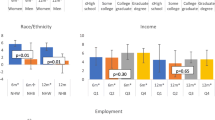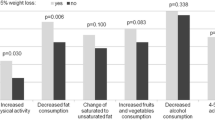Abstract
The U.S. Diabetes Prevention Program (DPP) showed that lifestyle participants who achieved ≥7% weight loss and ≥150 min/week physical activity experienced the greatest reduction in type 2 diabetes incidence. Demographic, clinical, and program factors that are related to achieving both these lifestyle goals have seldom been explored in community-delivered DPP programs. The purpose of this investigation is to examine factors associated with concurrent achievement of weight loss and physical activity goals in a 12-month community DPP lifestyle intervention. Adults [n = 223; age = 58.4 (SD = 11.5); BMI = 33.8 (SD = 6.0)] with glucose or HbA1c values in the pre-diabetes range and/or metabolic syndrome risk factors enrolled from one worksite and three community centers in the Pittsburgh, PA metropolitan area between January 2011 and January 2014. Logistic regression analyses determined the demographic, clinical and program adherence factors related to goal achievement at 6, 12, and 18 months. Participants achieving both intervention goals at 6 months (n = 57) were more likely to attend sessions [Adjusted Odds Ratio (AOR) =1.48], self-weigh (AOR = 1.19), and self-monitor behaviors (AOR = 1.18) than those meeting neither goal (n = 35; all p < 0.05). Baseline BMI (AOR = 0.87, p < 0.01), elevated glycemic status (AOR = 0.49, p < 0.05), and female sex (AOR = 0.52, p < 0.05) were inversely related to goal achievement at 6 months. Meeting either lifestyle goal at 6 months had the strongest association with meeting both goals at 12 and 18 months. Our study supports the importance of early engagement, regular attendance, self-monitoring, and self-weighing for goal achievement. Dissemination efforts should consider alternative approaches for those not meeting goals by 6 months to enhance long-term success.




Similar content being viewed by others
References
Centers for Disease Control and Prevention. (2014). National Diabetes Statistics Report: Estimates of diabetes and its burden in the Uniter States. U.S. Department of Health and Human Services, Atlanta, GA. Available at https://www.cdc.gov/diabetes/data/statistics/2014statisticsreport.html.
Ervin, R.B., Prevalence of metabolic syndrome among adults 20 years of age and over, by sex, age, race and ethnicity, and body mass index: United States, 2003–2006. Natl Health Stat Report, 2009; (13): p. 1–7.
Knowler, W. C., et al. (2002). Reduction in the incidence of type 2 diabetes with lifestyle intervention or metformin. New Engl J Med, 346(6), 393–403.
Tuomilehto, J., et al. (2001). Prevention of type 2 diabetes mellitus by changes in lifestyle among subjects with impaired glucose tolerance. The New England Journal of Medicine, 344(18), 1343–1350.
Pan, X. R., et al. (1997). Effects of diet and exercise in preventing NIDDM in people with impaired glucose tolerance. The da Qing IGT and diabetes study. Diabetes Care, 20(4), 537–544.
Kosaka, K., Noda, M., & Kuzuya, T. (2005). Prevention of type 2 diabetes by lifestyle intervention: A Japanese trial in IGT males. Diabetes Research and Clinical Practice, 67(2), 152–162.
Whittemore, R. (2011). A systematic review of the translational research on the diabetes prevention program. Translational Behavioral Medicine, 1(3), 480–491.
Johnson, M., et al. (2013). Can diabetes prevention programmes be translated effectively into real-world settings and still deliver improved outcomes? A synthesis of evidence. Diabetic Medicine, 30(1), 3–15.
Wing, R. R., et al. (2004). Achieving weight and activity goals among diabetes prevention program lifestyle participants. Obesity Research, 12(9), 1426–1434.
Wing, R. R., et al. (2006). A self-regulation program for maintenance of weight loss. The New England Journal of Medicine, 355(15), 1563–1571.
Amundson, H. A., et al. (2009). Translating the diabetes prevention program into practice in the general community: Findings from the Montana cardiovascular disease and diabetes prevention program. The Diabetes Educator, 35(2), 209–210 213-4, 216-20 passim.
Pinelli, N. R., et al. (2011). Family support is associated with success in achieving weight loss in a group lifestyle intervention for diabetes prevention in Arab Americans. Ethnicity & Disease, 21(4), 480–484.
Whittemore, R., et al. (2009). Translating the diabetes prevention program to primary care: A pilot study. Nursing Research, 58(1), 2–12.
Brokaw, S. M., et al. (2015). Effectiveness of an adapted diabetes prevention program lifestyle intervention in older and younger adults. Journal of the American Geriatrics Society, 63(6), 1067–1074.
Hamman, R. F., et al. (2006). Effect of weight loss with lifestyle intervention on risk of diabetes. Diabetes Care, 29(9), 2102–2107.
Taradash, J., et al. (2015). Recruitment for a diabetes prevention program translation effort in a worksite setting. Contemporary Clinical Trials, 41c, 204–210.
Kramer, M. K., et al. (2015). Improving employee health: Evaluation of a worksite lifestyle change program to decrease risk factors for diabetes and cardiovascular disease. Journal of Occupational and Environmental Medicine, 57(3), 284–291.
Eaglehouse, Y. L., et al. (2016). Impact of a community-based lifestyle intervention program on health-related quality of life. Quality of Life Research, 25(8), 1903–1912.
Eaglehouse, Y. L., et al. (2016). Physical activity levels in a community lifestyle intervention: A randomized trial. Transl J Am Coll Sports Med, 1(5), 45–51.
Kramer, M. K., et al. (2014). Diabetes prevention efforts in the community are effective for older, at-risk adults [abstract]. In: 74th Scientific Sessions of the American Diabetes Association. Diabetes. 63(Suppl 1): A1-A102.
Kerner, W., & Bruckel, J. (2014). Definition, classification and diagnosis of diabetes mellitus. Experimental and Clinical Endocrinology & Diabetes, 122(7), 384–386.
Grundy, S. M., et al. (2004). Definition of metabolic syndrome: Report of the National Heart, Lung, and Blood Institute/American Heart Association conference on scientific issues related to definition. Circulation, 109(3), 433–438.
Kramer, M. K., et al. (2009). Translating the diabetes prevention program: A comprehensive model for prevention training and program delivery. American Journal of Preventive Medicine, 37(6), 505–511.
Centers for Disease Control and Prevention. (2011). Centers for Disease Control and Prevention Diabetes Prevention Recognition Program: Standards and Operating Procedures. Available at www.cdc.gov/diabetes/prevention/recognition.
Wadden, T. A., & Butryn, M. L. (2003). Behavioral treatment of obesity. Endocrinology and Metabolism Clinics of North America, 32(4), 981–1003.
Kriska, A. M., & Caspersen, C. J. (1997). Introduction to the collection of physical activity questionnaires. Medicine and Science in Sports and Exercise, 29(6S), S5–S9.
Kriska, A. M., et al. (1990). Development of questionnaire to examine relationship of physical activity and diabetes in pima Indians. Diabetes Care, 13(4), 401–411.
Momenan, A. A., et al. (2012). Reliability and validity of the Modifiable activity questionnaire (MAQ) in an Iranian urban adult population. Archives of Iranian Medicine, 15(5), 279–282.
Pettee Gabriel, K., et al. (2011). Reliability and convergent validity of the past-week Modifiable activity questionnaire. Public Health Nutrition, 14(3), 435–442.
Kriska, A. M., et al. (2006). Physical activity in individuals at risk for diabetes: Diabetes prevention program. Medicine and Science in Sports and Exercise, 38(5), 826–832.
Peterson, B. L., & Harrell, F. E. (1990). Partial proportional odds models for ordinal response variables. Journal of the Royal Statistical Society, Series B(39), 205–217.
Wing, R. R., & Hill, J. O. (2001). Successful weight loss maintenance. Annual Review of Nutrition, 21, 323–341.
Butryn, M. L., et al. (2007). Consistent self-monitoring of weight: A key component of successful weight loss maintenance. Obesity (Silver Spring), 15(12), 3091–3096.
Williamson, D. A., Bray, G. A., & Ryan, D. H. (2015). Is 5% weight loss a satisfactory criterion to define clinically significant weight loss? Obesity (Silver Spring), 23(12), 2319–2320.
Unick, J. L., et al. (2014). Evaluation of early weight loss thresholds for identifying nonresponders to an intensive lifestyle intervention. Obesity (Silver Spring), 22(7), 1608–1616.
Unick, J. L., et al. (2015). Weight change in the first 2 months of a lifestyle intervention predicts weight changes 8 years later. Obesity (Silver Spring), 23(7), 1353–1356.
Miller, C. K., Nagaraja, H. N., & Weinhold, K. R. (2015). Early weight-loss success identifies nonresponders after a lifestyle intervention in a worksite diabetes prevention trial. Journal of the Academy of Nutrition and Dietetics, 115(9), 1464–1471.
Author information
Authors and Affiliations
Corresponding author
Ethics declarations
The study protocol was approved by the University of Pittsburgh Institutional Review Board (now the Human Research Protection Office). Written, informed consent was obtained from all individual participants included in the study. All procedures and research activities were in accordance with the ethical standards of the Institutional Review Board and in compliance with the 1964 Helsinki Declaration and its later amendments or comparable ethical standards.
Source of funding
Funding support was provided by the National Institutes of Health through grant number R18 DK081323–04 and grant number T32 CA186783 (postdoctoral training award for Dr. Eaglehouse). The funding agency did not have a role in the design and conduct of the study; in the collection, analysis and interpretation of the data; and in the preparation, review, or approval of the manuscript. The content is solely the responsibility of the authors and does not necessarily represent the official views of the National Institutes of Health.
Disclosure of potential conflicts of interest
The authors have no conflicts of interest to declare.
Additional information
Implications
Practice: Providers should reinforce early adoption of self-regulation behaviors and offer additional program support to those not achieving desired lifestyle goals within the first 6 months.
Policy: Policymakers should consider provision of coverage for healthy lifestyle programs for patients earlier in the diabetes-development process, i.e. when patients present with metabolic syndrome components even in the absence of prediabetes.
Research: Future efforts should evaluate other participant and program characteristics that impact on individual success at achieving weight and physical activity goals.
Electronic supplementary material
Table 1
(DOCX 13 kb)
About this article
Cite this article
Eaglehouse, Y.L., Venditti, E.M., Kramer, M. et al. Factors related to lifestyle goal achievement in a diabetes prevention program dissemination study. Behav. Med. Pract. Policy Res. 7, 873–880 (2017). https://doi.org/10.1007/s13142-017-0494-0
Published:
Issue Date:
DOI: https://doi.org/10.1007/s13142-017-0494-0




